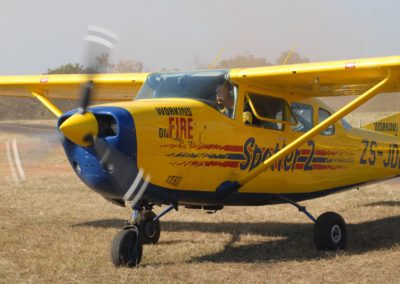Spotter pilots are specifically trained to ensure that aerial firefighting operations are undertaken safely and efficiently. When wildfires threaten farms and devour hectares worth of plantations, aerial firefighters are called in.
Aerial firefighting has a great impact on wildland firefighting operations. Aerial bombing does not effectively put out fires but firefighting pilots are able to cool down the fireline, enabling ground teams to move in closer and extinguish the flames.
Successful firefighting operations take teamwork, and aerial firefighters are integral members of that team. Circling above the burning inferno, we find another, less visual but vitally important, aerial firefighting resource – the command and control aircraft, also referred to as the “spotter”.
20 years ago, the command and control aircraft (usually high-wing Cessna’s) were coined spotter planes, as they were essentially commissioned to fly out and “spot” the fires. Modern technology has introduced electronic fire detection cameras which largely fill this fire detection role, while the spotter’s main priority now is the safety of the other aircraft and ground resources through a command and control function.
The spotter forms part of initial attack. He or she is usually dispatched ahead of the other resources. These pilots are specifically trained in advanced fire behaviour and are able to assess the fire and offer relevant real-time information to the Incident Commanders (IC) on the ground, who need the information to make informed decisions regarding tactics and resources.
Apart from air-to-ground communication, the spotter also manages air-to-air communication. They fly at a higher altitude than the other operational aircraft to maintain situational awareness and – in cooperation with the IC – direct the Hueys, with their Bambi buckets, and AT 802 fixed-wing water bombers to where water is most needed.
FireFly camera systems are installed on-board the command and control aircraft, which records and streams the events to the IC and landowners in their office. This gives the ground operations immediate and accurate insight into the fire’s behaviour and the effectiveness of the aerial and ground suppression actions.
The spotter usually only stands down once all the other aircraft have been demobilised and ground teams no longer require its assistance. As a result, the spotter may circle a fire for up to four hours before it has to land and refuel.
“Being a command and control pilot is my passion,” says Erick Nel, Command and Control pilot for Working on Fire (WOF) Aviation,which offers an aerial firefighting component to the South African Government’s WOF Programme.
“It is a very challenging job though and you need to multitask well. The cockpit can get very busy with all the observing and radio work – and then you still have to keep the plane in the air. But, I have been in aerial firefighting for 12 years and I think it is one of the most rewarding aviation jobs you can find. It is an honour to be part of a team who fights to save lives and livelihoods.”

Erick Nel, Spotter Command and Control pilot at work.
The importance of the spotter during aerial firefighting is often overlooked, but its function is essential for the safety and efficiency of wildland firefighting operational.










